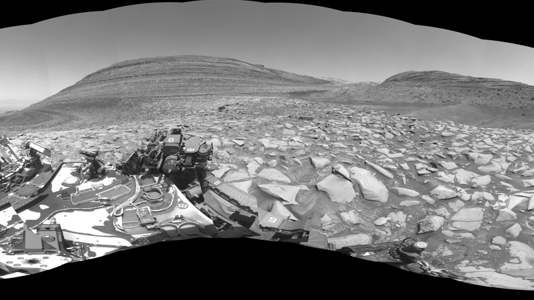The enigmatic landscape of Mars continues to captivate the imagination of scientists and space enthusiasts alike, offering tantalizing clues about the planet’s mysterious past. Recently, NASA’s Curiosity rover embarked on a new journey to explore Gediz Vallis, a winding channel that may have been carved by an ancient river. Through stunning panoramic images and meticulous scientific analysis, Curiosity’s exploration of Gediz Vallis promises to unveil new insights into Mars’ watery history and the potential for past habitability.
Gediz Vallis: A Window into Mars’ Ancient Rivers
As Curiosity rover arrives at Gediz Vallis, it encounters a rocky terrain characterized by the remnants of a winding channel etched into the Martian surface. The panoramic images captured by Curiosity’s navigation cameras offer a breathtaking glimpse of the channel’s geological features, including dark sand deposits, debris piles, and steep slopes. Scientists believe that Gediz Vallis may have been formed by the flow of water billions of years ago, during a time when Mars boasted rivers, lakes, and potentially even oceans.
Exploring the Origins of Gediz Vallis
One of the primary objectives of Curiosity’s mission at Gediz Vallis is to unravel the mysteries surrounding the channel’s formation. Scientists are eager to understand whether Gediz Vallis was sculpted by an ancient river, wind erosion, or other geological processes. By studying the composition of the channel’s bedrock, analyzing the distribution of boulders and debris, and examining the surrounding terrain, researchers hope to piece together the story of Mars’ dynamic past.
Implications for Mars’ Climate and Habitability
The exploration of Gediz Vallis holds profound implications for our understanding of Mars’ climate history and the potential for past habitability. The presence of a winding channel carved into the Martian landscape suggests that liquid water once flowed on the surface, shaping the planet’s terrain over time. This raises intriguing questions about the stability of Mars’ climate, the longevity of its water features, and the conditions that may have supported microbial life.
Insights from Mount Sharp and Beyond
Curiosity’s journey through Gediz Vallis builds upon its extensive exploration of the foothills of Mount Sharp, a towering peak located within Mars’ Gale Crater. By analyzing sedimentary layers and mineral compositions, Curiosity has uncovered evidence of past water activity and environmental conditions conducive to life. The discovery of clay minerals and sulfates in the region suggests a complex history of water interaction and geological evolution.
Looking Towards the Future of Martian Exploration
As Curiosity continues its mission on Mars, scientists eagerly anticipate the wealth of data and discoveries that await. From the exploration of ancient river channels to the analysis of Martian rocks and minerals, each new observation adds to our understanding of the Red Planet’s enigmatic past and its potential for harboring life. With future missions planned to further explore Mars’ surface and subsurface, the journey of exploration is far from over.
The exploration of Gediz Vallis by NASA’s Curiosity rover represents a significant milestone in our quest to unlock the secrets of Mars’ past. Through stunning imagery and groundbreaking scientific analysis, Curiosity offers a window into a world shaped by ancient rivers, shifting climates, and the possibility of life. As humanity continues to explore the Red Planet, each new discovery brings us closer to unraveling the mysteries of our celestial neighbor and expanding our understanding of the cosmos.
